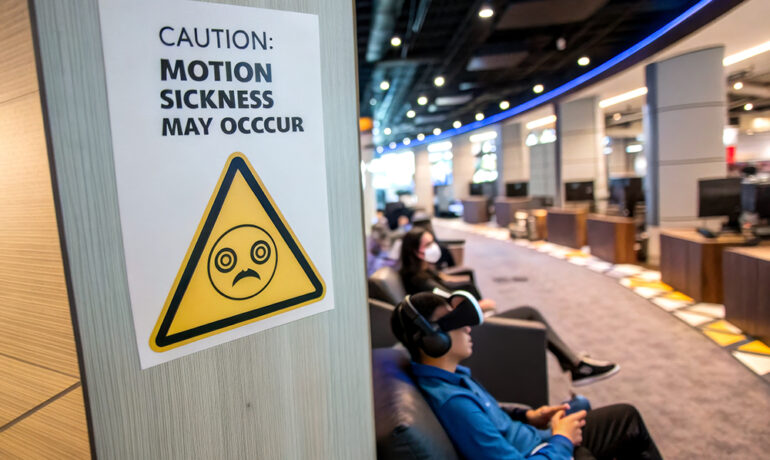Have you ever felt dizzy, nauseous, or disoriented after using virtual reality, watching an IMAX movie, or even working on a large monitor for hours? If so, you may be experiencing cybersickness—a modern form of motion sickness triggered by immersive or high-speed digital environments. While this may be a new term for many, the underlying causes are rooted in well-known issues involving eye coordination, focus, and the brain’s ability to process visual input.
At Rancho Santa Fe Optometry, we’re seeing patients experiencing these symptoms, and vision therapy is the solution for this condition.
What Is Cybersickness?
Cybersickness results from a mismatch between what your eyes see and what your body feels. For example, your eyes might detect rapid movement on a VR headset, but your body remains still. This disconnect between the vestibular system (which controls balance) and the visual system can lead to symptoms like:
1. Nausea
2. Headaches
3. Dizziness
4. Eye strain
5. Blurred vision
Many patients used to attribute these symptoms to computer vision syndrome, but today’s more immersive tech environments make the issue more complex—and more common.
Why Vision Therapy Helps
The core of cybersickness is often a problem with how your eyes work together. When the vestibulo-ocular reflex and binocular vision are out of sync, your brain receives mixed signals. This is where vision therapy comes in.
Vision therapy is a customized program of in-office and at-home exercises prescribed by an eye care professional. It trains your eyes and brain to improve coordination, focus, and tracking. For patients with vision therapy for strabismus or eye alignment issues, it can significantly reduce or eliminate cybersickness symptoms.
Whether you’re struggling with dizziness during screen time or visual discomfort after using VR, Rancho Santa Fe Optometry’s vision therapy for adults may be the solution.
Common Symptoms That May Indicate You Need Vision Therapy
1. Trouble focusing after screen use
2. Nausea while watching fast-moving video
3. Disorientation in large-format theaters
4. Eye fatigue after brief digital exposure
5. Difficulty with balance or spatial awareness
If you’re noticing these issues, don’t just push through them. A visit with an eye doctor specialist can help determine whether eye tracking therapy or other vision interventions are appropriate.
What to Expect at Rancho Santa Fe Optometry
Our experienced team offers full evaluations to uncover the root cause of your symptoms. We provide:
1. Functional vision testing and binocular vision analysis
2. Tailored vision therapy programs
3. Co-managed treatment with your neurologist or primary care doctor if needed
4. We take a holistic approach, ensuring that each patient’s visual system functions efficiently in both the real and virtual worlds.
Schedule an Appointment Today
At Rancho Santa Fe Optometry, our experienced team conducts comprehensive evaluations to identify the root cause of your symptoms. For patients experiencing cybersickness, visual discomfort, or eye coordination issues, we create personalized vision therapy programs to improve focus, tracking, and comfort. Our thorough approach ensures your visual system functions at its best in both real and virtual environments. Call (858) 465-5136 or request an appointment on our website today to take the first step toward more stable vision.
Frequently Asked Questions About Cybersickness
1. Is cybersickness the same as motion sickness?
Yes. Cybersickness is very similar to motion sickness, including car sickness. Both involve a sensory mismatch, where the brain receives conflicting information from the eyes and the inner ear (or other sensory systems) about motion. This conflict can lead to symptoms like nausea, dizziness, and disorientation.
2. How do the two differ?
Motion sickness typically occurs during physical travel (e.g., in a car or on a boat) when your body senses movement that your eyes do not.
Cybersickness, on the other hand, occurs when your eyes perceive motion in a virtual environment, but your body remains still.
The symptoms—nausea, dizziness, headache, and eye strain—are often identical, but the trigger is different.
3. Is cybersickness the same as VR sickness?
Yes, cybersickness and VR sickness are generally the same condition. Both are triggered by a visual-vestibular mismatch in a virtual environment, such as virtual reality headsets or simulation games. When your eyes register rapid motion that doesn’t match what your body feels, the resulting conflict can cause:
1. Nausea
2. Dizziness
3. Eye strain
4. Disorientation
While VR sickness is limited to virtual reality, cybersickness can also happen with regular digital media like 3D movies or fast-moving video games.
At Rancho Santa Fe Optometry we offer comprehensive eye examinations for all ages. With a focus on children’s vision and vision therapy, our doctors test for visual acuity, visual efficiency skills and visual information processing starting in early infancy. The practice also provides diagnosis, treatment and management of diseases that affect the human eye and visual system, including dry eye syndrome, diabetic retinopathy, cataracts, macular degeneration and keratoconus.
